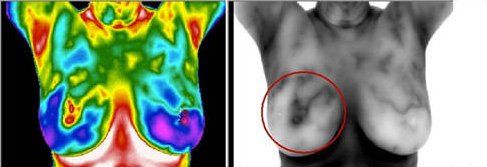Breast Screening
Breast
- Breast Cancer
- Dense Breast Tissue
- Fibrocystic Breast Condition
- Inflammatory Breast Cancer
Breast Cancer
Dense Breast Tissue
- Increases the chance that breast cancer may go undetected by a mammogram, since dense breast tissue can mask a potential cancer
- Increases your risk of breast cancer, though doctors aren't certain why
Like many women, this client has dense breast tissue. For her this has meant years of undergoing repeat mammograms, ultrasounds, MRIs, and biopsies, all ultimately finding nothing and subjecting her body to additional radiation and surgical procedures. Following the most recent mammogram she received the familiar letter that findings were inconclusive and that a repeat mammogram and ultrasound were needed. After years of hearing these same words she was tempted to skip the follow up, figuring it was, as in the past, nothing. Then she thought about another screening tool she had heard of, thermography. This client had her first thermography screening just two weeks following her annual mammogram. The thermogram showed an area pf suspicion and prompted her physician to further investigate, which ultimately lead to a cancer diagnosis.
Fibrocystic Breast Condition
Inflammatory Breast Cancer
Inflammatory breast cancer (IBC) is a very aggressive disease in which cancer cells block lymph vessels in the skin of the breast. Although IBC is rare, accounting for 1-5% of all breast cancers diagnosed in the US, it progresses rapidly, often in a matter of weeks or months. Its aggressive nature makes early detection critical. IBC is different than other forms of breast cancer, and it is difficult to diagnose. There is usually no lump that can be felt during physical examination, or detected with mammography or by ultrasound, and is often mistaken for infection.
Signs of IBC:
- Enlargement in one breast
- Bruised or pinkish-red appearance
- Heat radiating from the breast
- Dimpling on the surface of the skin
- Inverted nipple
- Pain or tenderness
- Enlarged lymph nodes around the area of the breast, under the arm or above the collar bone








